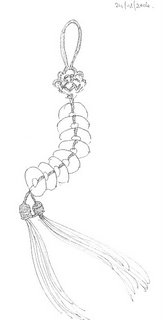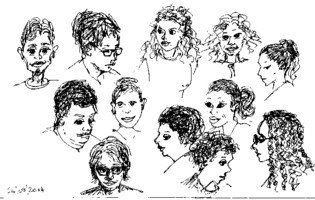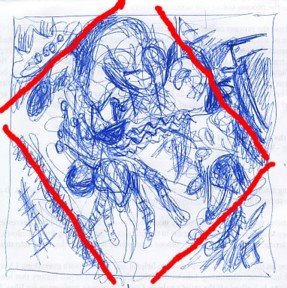
Thursday, August 31, 2006
Tuesday, August 29, 2006
An object with no name

On the first day of the seminar we met in a small room around a big conference table. There were about twelve of us in all. Leon introduced himself and the topic, and asked each of us to say what we expected. Now, the seminar title was rather general, even vague, so few people had any idea what to expect. Nevertheless we each came up with something, in my case what I hoped for. Leon then divided us into twos and threes and handed out some actual objects and images. Our group got the thing in the drawing. It consisted of pale green overlapping discs held together with red and gold threads, with a loop at one end and two long tassels at the other. We didn’t know what to make of it, except that it was oriental and maybe some sort of cheap ornament. I made a sketch/diagram of it as it lay on the table thinking that the scrutiny of drawing might turn up some fact we had missed (it didn't). Later on some of the members of the whole group recognized in it some sort of symbolic significance and suggested that the discs might be jade. Another group got a Japanese magazine which read from right to left and from “back to front” (as we would say). It showed how arbitrary our Western assumptions are, based on convention rather than on some deep law of nature. Some spirited discussion followed. The session ended with Leon allocating topics to be researched for the following week. Up to now I don’t know what the object is, its function or if it has a name.
Saturday, August 26, 2006
A recap
 Is it too soon for a recap? If a blog is thinking aloud then that is what I’m doing now. I chose these three drawings totally at random, they just happened to be nearby. They remind me that my natural instinct is for variety which in these days of the tyranny of the theme could be a bad thing. There are three types of drawing here: 1) a drawing from life (the old lady in the wheelchair); 2) an analytical drawing of an abstract painting, and 3) a drawing from memory. I doubt that classifying them in this way is the least bit helpful, though I did recently come across a claim by a 19th century British writer that all thinking is classification, or something to that effect. I will look for the quote. It bothered me at the time because it had a dogmatic, closed-mind kind of ring. Plus, in terms of classifying I’m a joiner and not a splitter. I tend to look for common factors. In these three drawings a common factor is that they’re all scribbled, they’re not neat or tidy. This suggests that my intention in making them was not to make presentable drawings of the kind you could frame and sell. Which brings up the matter of “the artist’s intention”, a whole subject by itself, with its attendant theories and controversies particularly in the last fifty years. To put down my stake: in my view figuring out the artist's intention is the surest straightest route to understanding art.
Is it too soon for a recap? If a blog is thinking aloud then that is what I’m doing now. I chose these three drawings totally at random, they just happened to be nearby. They remind me that my natural instinct is for variety which in these days of the tyranny of the theme could be a bad thing. There are three types of drawing here: 1) a drawing from life (the old lady in the wheelchair); 2) an analytical drawing of an abstract painting, and 3) a drawing from memory. I doubt that classifying them in this way is the least bit helpful, though I did recently come across a claim by a 19th century British writer that all thinking is classification, or something to that effect. I will look for the quote. It bothered me at the time because it had a dogmatic, closed-mind kind of ring. Plus, in terms of classifying I’m a joiner and not a splitter. I tend to look for common factors. In these three drawings a common factor is that they’re all scribbled, they’re not neat or tidy. This suggests that my intention in making them was not to make presentable drawings of the kind you could frame and sell. Which brings up the matter of “the artist’s intention”, a whole subject by itself, with its attendant theories and controversies particularly in the last fifty years. To put down my stake: in my view figuring out the artist's intention is the surest straightest route to understanding art.
Friday, August 25, 2006
Memory of a seminar
This is a memory drawing of a group of people at a seminar. The seminar was called Exploring Ideas about Objects and Images, and it was held in 2004 at CCA7. The drawing was done a few hours after the first session. Some of the people are: at top left, Leon, the tutor, or my inept memory of him at that time; at right, two well-known Trinidadian artists; and that’s me at bottom left. The course consisted of one three-hour session a week for four weeks and we had to do research in between. It was brilliant, one of the most electrifying learning experiences I’ve ever had. What was it about? Well, generally it was in the field of art history or art appreciation, and within that it was whatever you wanted it to be. I wanted to have a better understanding of conceptual art and by the end of the course that’s what I had.
Thursday, August 24, 2006
Subscribe to:
Posts (Atom)


